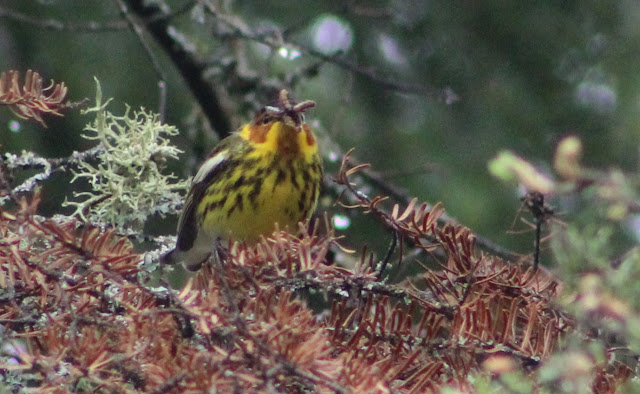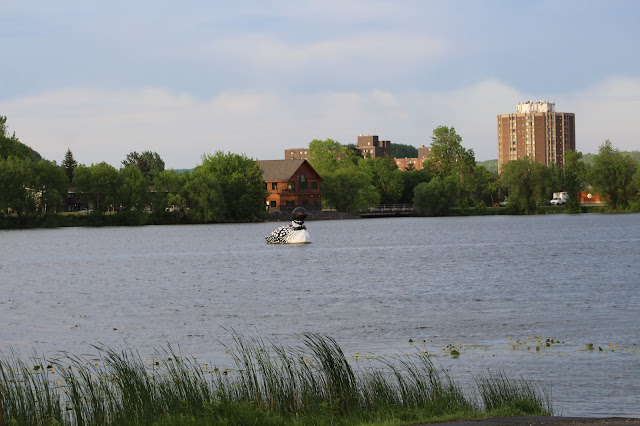It was still June 6th, and when I entered into Cook County I was stoked that I had reached Minnesota's northeastern-most county, and it is a county that is famed and well talked about among Minnesota birders. Cook County hosts vast boreal forests, bogs, lakes, rivers, and the shoreline of Lake Superior. When I entered Cook I started to do a few incidental eBird checklists. However, I did have an issue arise, which was weather. As I was scheduled to get on the Gunflint Trail and drive it's length from Highway 61 around 3 P.M., I realized that the remainder of the 6th was supposed to be sunny with some clouds rolling in overnight. But on the morning and most of the day on June 7th, indications were that a steady rain would take place in most of the region of Cook County. I was bummed out of the news, and I hoped that the rain wouldn't be as bad as forecasts were saying. Regardless, I had about six hours of daylight to explore along Gunflint on the current day, and if it rained all day on the 7th, I would simply see it as a sight-seeing trek along the entire Gunflint Trail. While I wanted to see as many birds as possible, I guess the rain didn't effect my main target of being in this area and seeing it. And I also didn't see it as really effecting my chances of seeing the creature that I wanted to target most on Gunflint, which was the Moose.
When I turned on Gunflint to head northward, the entry signs said it all. I was in freaking Moose Country.
As I headed north, I made a few stops here and there to enjoy scenery and to start building my Cook County list. When I saw a sign indicating, "Moose Viewing Trail", I had to stop, get out, and start hiking to a platform that would overlook a small lake. Apparently, Moose come down to the lake to eat and drink quite often. A lady I ran into on my way said no Moose were currently present, and that I should try at dusk. In the woods surrounding the trail made up of conifers and deciduous trees, the forest was made alive by Black-throated Green Warblers, Blackburnian Warblers, and Swainson's Thrushes.
After the Moose trail, I took some time to drive a good distance north on Gunflint before deciding to turn around and spend as much time birding as possible. Gunflint Trail hosts the possibility for finding breeding Boreal Owls, Spruce Grouse, Black-backed and Three-toed Woodpeckers, and over 20 species of breeding warblers. For my trip, I had written 26 species of warblers down that I could encounter on the trip in northern parts of the three states. At this point of the trip, I had 24 of them, and the only two remaining warblers I had to find for the trip were Wilson's and Bay-breasted Warblers. In Minnesota, Gunflint Trail is the best place to look for both species. After going north on Gunflint, I worked my way south to bird a road called Forest Road 325. It would go for a ways and would connect with other roads, including a road called Forest Road 315, which went along and accessed a birder-famous ridge called Lima Mountain. I didn't have time to cover as much as I wanted to on the 6th, but I hoped the rain would be reduced on the following day. For the limited time I had and with wanting to search for Moose in the evening, I stuck to FR 325. A mix of coniferous and deciduous forest filled the area, as well as some bogs. I didn't try to photograph too many birds, but several species were still cooperative.
 |
| White-throated Sparrow |
 |
| Chestnut-sided Warbler |
 |
| A striking Canada Warbler |
As I continued on from the Lima Mountain area, I started to search for Moose. I was blown away by the beauty of this area, and when I was on Gunflint, I kept forgetting I was in Minnesota. It was hard to say I was anywhere. Few places that I have been to in my life have made me say this.
I didn't see any Moose on the evening of the 6th, despite covering as much of Gunflint as I could, and another visit to the Moose Viewing Trail at dusk. Here is a video of the small lake, as well as a video of singing Swainson's Thrushes.
Although I didn't see any Moose, I was happy to encounter a few Snowshoe Hares and a Red Fox along Gunflint with a recent kill he made.
Once it got dark out, I settled down at a campground for the night before an early start the next morning. Once morning and June 7th hit, my plan was to cruise for Moose again, with this time being at dawn. The skies were cloudy, and as I decided to drive to the Gunflint Trail's ending mark of 57 miles, the rain started to come down within the first hour, and there weren't any signs of it stopping. I still got out and birded in random locations, but I wasn't able to take pictures because the rain stayed consistent and I didn't want my camera to get harmed. The drive up and down Gunflint was amazing, and I enjoyed the incredible scenery. I still couldn't grasp where I was, and I kept reminding myself that I was in Minnesota! As I drove up slowly to the end of Gunflint and searched for Moose, I was coming up empty. Despite the rain, dozens and dozens of cars were coming up with their canoes. I went to a trail head and saw that some of the hiking areas required permits too. It made me wish I could stay along Gunflint for a week to really explore the area well.
When I reached the ending point of Gunflint, I drove back down slowly as the rain kept coming down and down and down. I treated it as a scouting trip for the future when I hope to come back someday. Things happened fast and quick and the highway took an awesome turn when the turn luckily had a young male Moose in the middle of Gunflint! As soon as he saw me, he got a little nervous and went back into some thick habitat that was by the side of the road. I didn't have room to pull over at that point in driving, but as I drove by slowly, I could see the Moose's upper body over shrubby roadside habitat it had gone into. I couldn't believe it, and I managed to snap a few poor but diagnostic images.
The Moose was a big score for me on this trip. I found a pull off up the road further and tried to see the Moose again, but it went into some dense forest and remained out of sight. I then pulled off of the side of the road for some birding. One spot had a river flowing nearby and thick stands of conifers. A handful of different warblers were represented by Northern Waterthrush and Cape May Warbler. I wished the rain wasn't as bad as it was, or otherwise I'd likely have more bird pictures to display. Driving more of the Lima Mountain area was fun and was worth exploring.
When a came upon a stretch where I was able to get cell phone service from, I pulled up the weather and looked at the radar. As it pinpointed my location, I realized that the rain was going to continue through 2 to 3 P.M. As I was planning on birding Sax-Sim Bog on the 8th, I did want to leave Gunflint around 3 P.M. I didn't like the weather conditions and it was appearing very likely that rain would eat up the rest of that day. I scrolled down to Lake County and looked at the radar along County Road 1, which is near County Road 2 where I spent the morning earlier in the trip in a successful hunt for Cape May Warblers. According to the radar, the rain would disappear when I would get there around 1 PM, and then it would put me an hour away from where I'd need to stay in Angora, Minnesota for that night. It was tough to make a decision to leave Gunflint and Cook County, but I had to if I wanted to have more successful birding that day, and more birding time. Someday, I hope to stay at the Gunflint Trail for 4 to 5 days to the point where I can explore the area with much more time. Regardless, I'm proud to say I birded Cook County, Minnesota, where I detected an even 50 bird species in the shortened time that I was there. I shot a video of the drive as I was leaving the rainy, but beautiful, Gunflint Trail.
Bird wise, there were several Cape May Warblers. One of them showed pretty well, but I was hoping for something a little closer. And it looks like he was eating some of those freaking spruce budworms!
This Ovenbird was fun to observe for a few minutes, and it walked across branches and sang it's head off, proclaiming, "Teacher! Teacher! Teacher! Teacher!".
After Spruce Road, I was thinking about going elsewhere, such as a thirty minute drive to a few spots I covered earlier on the trip on County Road 2. I noticed that I had plenty of awesome habitat near where I was at at County Road 1 and Spruce Road, and I decided to spend the remaining hours that I had left before heading to my hotel in Angora right along roads that were less than a mile away from Spruce Road. I ended up liking the decision, and I was tired of driving. As I went short distances down County Road 1, I found 3 roads to walk down and explore, as well as walking right along County Road 1 itself.
A male Blackburnian Warbler was awesome to see, as usual.
A big surprise came when this Black-backed Woodpecker came and landed on a conifer at a very close range to me. I was shocked, and this is the best look I've ever had of this species, which I had only seen a few times previously!
I joined my family for a quick and planned ten minutes via Zoom chat online and by using my data. The cell coverage was decent in the area. When I heard a Cape May Warbler singing right at my limit of ten minutes on the data and battery-eating Zoom chat, I knew it time for me to go. And that Cape May Warbler gave me everything! I couldn't have asked for any better as the bird gave me an absolute show while it foraged low for a quick stint in midst of singing high up in conifers.
Here's a recording video I was able to get of the Cape May Warbler.
The area I spent birding was awesome, and I'm glad I did much more birding and much less driving. I did want to be to my room in Angora by 7 P.M. and to bed by 8 PM, as I wanted to have a lot of energy for the next day when I would bird at the legendary Sax-Sim Bog the next day, which was only 30 minutes from Angora. As I drove through Angora to get some food after checking in, I thought this gigantic Common Loon out on a town-park lake was awesome.
Up next on Northery Treks is as I mentioned, a visit to the legendary Sax-Sim Bog.































































No comments:
Post a Comment